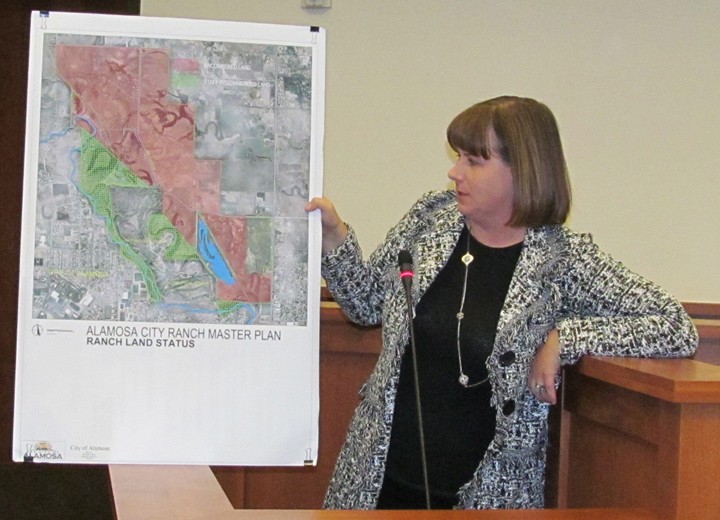City firms up ranch plan

ALAMOSA — A conservation easement may protect a portion of the Alamosa Ranch in the future.
City council and staff in a recent work session discussed the status of a proposed revised ranch plan including the possibility of pursuing a conservation easement for at least a portion of the ranch.
Alamosa City Manager Heather Brooks reminded the city council that the push for a revised and more specific ranch plan arose out of the Rio Bravo Resort discussions. The city subsequently undertook a ranch plan revision process and received public comments through public meetings and the city’s web site. City Planning and Development Specialist Dan Vaughn said the city received more than 40 comments on the city’s web site.
City staff also outlined characteristics of the ranch property such as soil types and developed a plan for potential uses of various sections of the ranch.
Brooks said much of the ranch uses would remain as is (ranching for example) while some areas could see low-level recreational development. The plan also outlines areas for development along Highway 17, although no specific proposals are currently before the council and the city is not seeking any out, Brooks said.
The Rio Bravo Resort is still pending, and the city and developers have not yet completed the land exchange.
“These lines are not hard and fast,” Brooks commented on the proposed ranch plan map.
Brooks said that as the ranch input and plan development process proceeded, her perspective on conservation easements began to change. She was not in favor of a conservation easement on the ranch initially, she said, because it would bind the city in the future. A compromise would be for voters to approve a conservation easement on part of the ranch, which could not be changed without voter approval in the future.
Brooks said she believes now that at least a portion of the ranch might be suitable for a conservation easement, especially if the city could receive enough compensation for doing so, with proceeds used to enhance the ranch property. Several organizations work with landowners to set up conservation easements and provide compensation to the landowners for those easements. Vaughn said Trust for Public Lands is involved in conservation easements, for example.
Property along the river, for example, would be appropriate for the enhanced level of protection a conservation easement would provide, Brooks explained.
Brooks said preliminary numbers were around $200,000 the city could receive for a conservation easement, which could then be invested into ranch property projects such as trails or a pedestrian bridge. Although $200,000 would not be enough to construct a pedestrian bridge, it could be used as a match for a Great Outdoors Colorado (GOCO) grant.
“If we could bring in somewhere close to that to re-invest, we very much feel that would be appropriate,” Brooks said. If the city would receive less than $200,000 for a conservation easement, she would probably recommend the voter-approved protection of a portion of the ranch instead.
“Staff recommendation is not for a conservation easement for the entire property,” Brooks said. She said some of the public comment the city received was to put the whole ranch under a conservation easement, but that would not be the staff’s recommendation.
The city might not be able to legally put the entire ranch under a conservation easement, Brooks added, because the city’s water augmentation plan uses a significant portion of the ranch as leverage for that financing. A portion of the ranch not encumbered by the augmentation plan might be suitable, however.
Councilor Kristina Daniel said she was initially skeptical of a conservation easement but was more open to it as long as there was flexibility. She said it made more sense to her to conserve areas along the river, for example.
“I think there are parts of this ranch that should never be touched,” said Councilman Jan Vigil. “It’s such a pristine area … I think there are places on this ranch that should be protected from any development.”
He agreed that certain areas could be targeted for future economic development as well.
Brooks and City Parks Director Andy Rice said the recreation board support a conservation easement on a portion of the ranch as long as recreational activities would still be permitted. Rice said the city needs to be open to the next popular recreational activity, just like disc golf exploded in popularity.
Alamosa Mayor Ty Coleman said it is important the city provides for future opportunities and does not tie its hands for potential economic development.
Brooks said city staff would now develop a final ranch proposal that will be presented again to the recreation advisory board, which would recommend final adoption to the city council.
Brooks added that if the city council were interested in pursuing a conservation easement, staff would look into the market. She said the market is not as big for public entities like the city, and some organizations that fund conservation easements do not do them for governments. She said some funders believe governments should shoulder this type of thing themselves. However, she said the city could does not have money in its budget for some of the projects like the pedestrian bridge, and a conservation easement compensating the city for $200,000 or more “could be a game changer for that area.”



